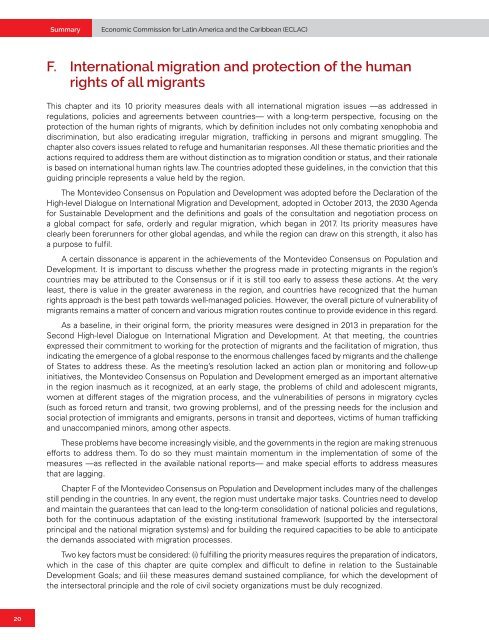Draft first regional report on the implementation of the Montevideo Consensus on Population and Development
This draft report seeks to give an account of progress in the implementation of the priority measures of the Montevideo Consensus on Population and Development in the region, as well as the differences between countries in terms of the degree of implementation. By highlighting relevant national experiences, it also seeks to facilitate the exchange of good practices among countries so that they can benefit from each other in their efforts to advance the implementation of the actions of the Montevideo Consensus.
This draft report seeks to give an account of progress in the implementation of the priority measures of the Montevideo Consensus on Population and Development in the region, as well as the differences between countries in terms of the degree of implementation. By highlighting relevant national experiences, it also seeks to facilitate the exchange of good practices among countries so that they can benefit from each other in their efforts to advance the implementation of the actions of the Montevideo Consensus.
Create successful ePaper yourself
Turn your PDF publications into a flip-book with our unique Google optimized e-Paper software.
Summary<br />
Ec<strong>on</strong>omic Commissi<strong>on</strong> for Latin America <strong>and</strong> <strong>the</strong> Caribbean (ECLAC)<br />
F. Internati<strong>on</strong>al migrati<strong>on</strong> <strong>and</strong> protecti<strong>on</strong> <strong>of</strong> <strong>the</strong> human<br />
rights <strong>of</strong> all migrants<br />
This chapter <strong>and</strong> its 10 priority measures deals with all internati<strong>on</strong>al migrati<strong>on</strong> issues —as addressed in<br />
regulati<strong>on</strong>s, policies <strong>and</strong> agreements between countries— with a l<strong>on</strong>g-term perspective, focusing <strong>on</strong> <strong>the</strong><br />
protecti<strong>on</strong> <strong>of</strong> <strong>the</strong> human rights <strong>of</strong> migrants, which by definiti<strong>on</strong> includes not <strong>on</strong>ly combating xenophobia <strong>and</strong><br />
discriminati<strong>on</strong>, but also eradicating irregular migrati<strong>on</strong>, trafficking in pers<strong>on</strong>s <strong>and</strong> migrant smuggling. The<br />
chapter also covers issues related to refuge <strong>and</strong> humanitarian resp<strong>on</strong>ses. All <strong>the</strong>se <strong>the</strong>matic priorities <strong>and</strong> <strong>the</strong><br />
acti<strong>on</strong>s required to address <strong>the</strong>m are without distincti<strong>on</strong> as to migrati<strong>on</strong> c<strong>on</strong>diti<strong>on</strong> or status, <strong>and</strong> <strong>the</strong>ir rati<strong>on</strong>ale<br />
is based <strong>on</strong> internati<strong>on</strong>al human rights law. The countries adopted <strong>the</strong>se guidelines, in <strong>the</strong> c<strong>on</strong>victi<strong>on</strong> that this<br />
guiding principle represents a value held by <strong>the</strong> regi<strong>on</strong>.<br />
The M<strong>on</strong>tevideo C<strong>on</strong>sensus <strong>on</strong> Populati<strong>on</strong> <strong>and</strong> <strong>Development</strong> was adopted before <strong>the</strong> Declarati<strong>on</strong> <strong>of</strong> <strong>the</strong><br />
High-level Dialogue <strong>on</strong> Internati<strong>on</strong>al Migrati<strong>on</strong> <strong>and</strong> <strong>Development</strong>, adopted in October 2013, <strong>the</strong> 2030 Agenda<br />
for Sustainable <strong>Development</strong> <strong>and</strong> <strong>the</strong> definiti<strong>on</strong>s <strong>and</strong> goals <strong>of</strong> <strong>the</strong> c<strong>on</strong>sultati<strong>on</strong> <strong>and</strong> negotiati<strong>on</strong> process <strong>on</strong><br />
a global compact for safe, orderly <strong>and</strong> regular migrati<strong>on</strong>, which began in 2017. Its priority measures have<br />
clearly been forerunners for o<strong>the</strong>r global agendas, <strong>and</strong> while <strong>the</strong> regi<strong>on</strong> can draw <strong>on</strong> this strength, it also has<br />
a purpose to fulfil.<br />
A certain diss<strong>on</strong>ance is apparent in <strong>the</strong> achievements <strong>of</strong> <strong>the</strong> M<strong>on</strong>tevideo C<strong>on</strong>sensus <strong>on</strong> Populati<strong>on</strong> <strong>and</strong><br />
<strong>Development</strong>. It is important to discuss whe<strong>the</strong>r <strong>the</strong> progress made in protecting migrants in <strong>the</strong> regi<strong>on</strong>’s<br />
countries may be attributed to <strong>the</strong> C<strong>on</strong>sensus or if it is still too early to assess <strong>the</strong>se acti<strong>on</strong>s. At <strong>the</strong> very<br />
least, <strong>the</strong>re is value in <strong>the</strong> greater awareness in <strong>the</strong> regi<strong>on</strong>, <strong>and</strong> countries have recognized that <strong>the</strong> human<br />
rights approach is <strong>the</strong> best path towards well-managed policies. However, <strong>the</strong> overall picture <strong>of</strong> vulnerability <strong>of</strong><br />
migrants remains a matter <strong>of</strong> c<strong>on</strong>cern <strong>and</strong> various migrati<strong>on</strong> routes c<strong>on</strong>tinue to provide evidence in this regard.<br />
As a baseline, in <strong>the</strong>ir original form, <strong>the</strong> priority measures were designed in 2013 in preparati<strong>on</strong> for <strong>the</strong><br />
Sec<strong>on</strong>d High-level Dialogue <strong>on</strong> Internati<strong>on</strong>al Migrati<strong>on</strong> <strong>and</strong> <strong>Development</strong>. At that meeting, <strong>the</strong> countries<br />
expressed <strong>the</strong>ir commitment to working for <strong>the</strong> protecti<strong>on</strong> <strong>of</strong> migrants <strong>and</strong> <strong>the</strong> facilitati<strong>on</strong> <strong>of</strong> migrati<strong>on</strong>, thus<br />
indicating <strong>the</strong> emergence <strong>of</strong> a global resp<strong>on</strong>se to <strong>the</strong> enormous challenges faced by migrants <strong>and</strong> <strong>the</strong> challenge<br />
<strong>of</strong> States to address <strong>the</strong>se. As <strong>the</strong> meeting’s resoluti<strong>on</strong> lacked an acti<strong>on</strong> plan or m<strong>on</strong>itoring <strong>and</strong> follow-up<br />
initiatives, <strong>the</strong> M<strong>on</strong>tevideo C<strong>on</strong>sensus <strong>on</strong> Populati<strong>on</strong> <strong>and</strong> <strong>Development</strong> emerged as an important alternative<br />
in <strong>the</strong> regi<strong>on</strong> inasmuch as it recognized, at an early stage, <strong>the</strong> problems <strong>of</strong> child <strong>and</strong> adolescent migrants,<br />
women at different stages <strong>of</strong> <strong>the</strong> migrati<strong>on</strong> process, <strong>and</strong> <strong>the</strong> vulnerabilities <strong>of</strong> pers<strong>on</strong>s in migratory cycles<br />
(such as forced return <strong>and</strong> transit, two growing problems), <strong>and</strong> <strong>of</strong> <strong>the</strong> pressing needs for <strong>the</strong> inclusi<strong>on</strong> <strong>and</strong><br />
social protecti<strong>on</strong> <strong>of</strong> immigrants <strong>and</strong> emigrants, pers<strong>on</strong>s in transit <strong>and</strong> deportees, victims <strong>of</strong> human trafficking<br />
<strong>and</strong> unaccompanied minors, am<strong>on</strong>g o<strong>the</strong>r aspects.<br />
These problems have become increasingly visible, <strong>and</strong> <strong>the</strong> governments in <strong>the</strong> regi<strong>on</strong> are making strenuous<br />
efforts to address <strong>the</strong>m. To do so <strong>the</strong>y must maintain momentum in <strong>the</strong> implementati<strong>on</strong> <strong>of</strong> some <strong>of</strong> <strong>the</strong><br />
measures —as reflected in <strong>the</strong> available nati<strong>on</strong>al <str<strong>on</strong>g>report</str<strong>on</strong>g>s— <strong>and</strong> make special efforts to address measures<br />
that are lagging.<br />
Chapter F <strong>of</strong> <strong>the</strong> M<strong>on</strong>tevideo C<strong>on</strong>sensus <strong>on</strong> Populati<strong>on</strong> <strong>and</strong> <strong>Development</strong> includes many <strong>of</strong> <strong>the</strong> challenges<br />
still pending in <strong>the</strong> countries. In any event, <strong>the</strong> regi<strong>on</strong> must undertake major tasks. Countries need to develop<br />
<strong>and</strong> maintain <strong>the</strong> guarantees that can lead to <strong>the</strong> l<strong>on</strong>g-term c<strong>on</strong>solidati<strong>on</strong> <strong>of</strong> nati<strong>on</strong>al policies <strong>and</strong> regulati<strong>on</strong>s,<br />
both for <strong>the</strong> c<strong>on</strong>tinuous adaptati<strong>on</strong> <strong>of</strong> <strong>the</strong> existing instituti<strong>on</strong>al framework (supported by <strong>the</strong> intersectoral<br />
principal <strong>and</strong> <strong>the</strong> nati<strong>on</strong>al migrati<strong>on</strong> systems) <strong>and</strong> for building <strong>the</strong> required capacities to be able to anticipate<br />
<strong>the</strong> dem<strong>and</strong>s associated with migrati<strong>on</strong> processes.<br />
Two key factors must be c<strong>on</strong>sidered: (i) fulfilling <strong>the</strong> priority measures requires <strong>the</strong> preparati<strong>on</strong> <strong>of</strong> indicators,<br />
which in <strong>the</strong> case <strong>of</strong> this chapter are quite complex <strong>and</strong> difficult to define in relati<strong>on</strong> to <strong>the</strong> Sustainable<br />
<strong>Development</strong> Goals; <strong>and</strong> (ii) <strong>the</strong>se measures dem<strong>and</strong> sustained compliance, for which <strong>the</strong> development <strong>of</strong><br />
<strong>the</strong> intersectoral principle <strong>and</strong> <strong>the</strong> role <strong>of</strong> civil society organizati<strong>on</strong>s must be duly recognized.<br />
20


















